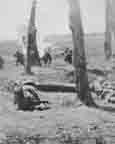
The war films of 1917-18 had been filmed far from the front by men who knew little of modern war, and their routine heroics and humor were continued in formula films through the early Twenties. Only when actual veterans like Laurence Stallings, John Monk Saunders, William Wellman, and Dick Grace got into film-making did Hollywood movies begin to render the real flavor of what was to a whole generation of Americans the most overwhelming experience of their lives. Of all the films originated, The Big Parade was and remains the outstanding achievement. King Vidor's filming of the battle scenes in Laurence Stallings' story so excited the producer, Irving Thalberg, that he suggested that they be lengthened and featured in the film above its romance and comedy. Vidor was deliberately trying to introduce a new view of modern war and especially of infantry fighting. From much screening of wartime newsreels and Signal Corps records, he had observed that the pace of men moving into combat has a characteristic rhythm, which he imitated for the camera, and he cut his battle sequences at the same measured pace. The result was an illusion of experience and close participation in the action still unique in fictional war films.
The Big Parade did not, like plays and novels written by intellectuals, debunk war or deplore its causes. Both its artistic strength and its immense popular appeal stemmed from a certain neutral outlook, the viewpoint of the ordinary soldier to whom war may be hell but who is not concerned with whether it is morally or socially wrong. Vidor himself has described the picture he tried to paint: "A man walks through the war and looks at it, neither a pacifist nor a soldier, he simply goes through and has a look and is pulled into these experiences."
In addition to the authenticity of its battle scenes, The Big Parade portrayed with acute realism the affection amounting to love which grows up between men under combat conditions, and the frenzy of women parted from their lovers in the shadow of death. No one who has seen it will ever forget the scene in which Renee Adoree clings first to John Gilbert's boot and then to the truck which is carrying him away, in a compulsive attempt to prevent the inevitable.